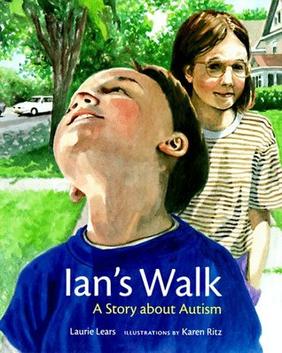Ian's Walk
Ian's Walk: A Story about Autism
"Ian's Walk: A Story about Autism" is a children's picture book written by Laurie Lears and illustrated by Karen Ritz. The book was published in 1998 and is recognized for its sensitive portrayal of autism through the eyes of a sibling. It is often used as an educational tool to help children understand autism and the experiences of those who have it.
Plot Summary[edit | edit source]
The story follows a young girl named Julie and her brother Ian, who has autism. Julie, along with her sister Tara, takes Ian for a walk to the park. Throughout the walk, Julie observes how Ian experiences the world differently. He is fascinated by the sensory details that others might overlook, such as the feel of bricks or the sound of a bell. Julie initially feels frustrated by Ian's behavior, but when Ian wanders off and gets lost, she realizes the importance of understanding and accepting his unique perspective.
Themes[edit | edit source]
"Ian's Walk" explores several important themes:
- Understanding and Acceptance: The book emphasizes the importance of understanding and accepting individuals with autism. Julie's journey from frustration to empathy highlights the need for patience and compassion.
- Sibling Relationships: The story delves into the dynamics of sibling relationships, particularly when one sibling has special needs. It portrays the challenges and rewards of having a sibling with autism.
- Sensory Perception: Ian's unique way of interacting with the world is a central focus of the book. It provides insight into the sensory experiences of individuals with autism, helping readers appreciate different perspectives.
Reception[edit | edit source]
"Ian's Walk" has been praised for its realistic and respectful depiction of autism. Educators and parents often use the book as a resource to teach children about autism and to foster empathy and understanding. The illustrations by Karen Ritz complement the narrative by visually representing Ian's sensory experiences.
Educational Use[edit | edit source]
The book is frequently used in educational settings to:
- Introduce discussions about autism and diversity.
- Encourage empathy and understanding among students.
- Provide a starting point for conversations about sensory differences and how they affect individuals.
Also see[edit | edit source]
References[edit | edit source]
- Lears, Laurie. "Ian's Walk: A Story about Autism." Illustrated by Karen Ritz, Albert Whitman & Company, 1998.
External links[edit | edit source]
- [Publisher's page on "Ian's Walk"](https://www.albertwhitman.com/book/ians-walk-a-story-about-autism/)
- [Author's biography](https://www.laurielears.com)
Search WikiMD
Ad.Tired of being Overweight? Try W8MD's physician weight loss program.
Semaglutide (Ozempic / Wegovy and Tirzepatide (Mounjaro / Zepbound) available.
Advertise on WikiMD
|
WikiMD's Wellness Encyclopedia |
| Let Food Be Thy Medicine Medicine Thy Food - Hippocrates |
Translate this page: - East Asian
中文,
日本,
한국어,
South Asian
हिन्दी,
தமிழ்,
తెలుగు,
Urdu,
ಕನ್ನಡ,
Southeast Asian
Indonesian,
Vietnamese,
Thai,
မြန်မာဘာသာ,
বাংলা
European
español,
Deutsch,
français,
Greek,
português do Brasil,
polski,
română,
русский,
Nederlands,
norsk,
svenska,
suomi,
Italian
Middle Eastern & African
عربى,
Turkish,
Persian,
Hebrew,
Afrikaans,
isiZulu,
Kiswahili,
Other
Bulgarian,
Hungarian,
Czech,
Swedish,
മലയാളം,
मराठी,
ਪੰਜਾਬੀ,
ગુજરાતી,
Portuguese,
Ukrainian
Medical Disclaimer: WikiMD is not a substitute for professional medical advice. The information on WikiMD is provided as an information resource only, may be incorrect, outdated or misleading, and is not to be used or relied on for any diagnostic or treatment purposes. Please consult your health care provider before making any healthcare decisions or for guidance about a specific medical condition. WikiMD expressly disclaims responsibility, and shall have no liability, for any damages, loss, injury, or liability whatsoever suffered as a result of your reliance on the information contained in this site. By visiting this site you agree to the foregoing terms and conditions, which may from time to time be changed or supplemented by WikiMD. If you do not agree to the foregoing terms and conditions, you should not enter or use this site. See full disclaimer.
Credits:Most images are courtesy of Wikimedia commons, and templates Wikipedia, licensed under CC BY SA or similar.
Contributors: Prab R. Tumpati, MD

